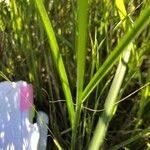Plants densely cespitose. Culms 25–120 cm; vegetative culms inconspicuous with few leaves clustered at apex. Leaves: sheaths conspicuously green-veined adaxially nearly to apex, narrow hyaline band or sharp Y-shaped region at collar, adaxially firm, summits U-shaped, not prolonged; distal ligules 1.5–4.5 mm; blades 3–5 per fertile culm, 9–25 cm × 2–3.5 mm. Inflorescences erect, open, yellow-green to brown, 1.5–4 cm × 4–12 mm; proximal internode 3–12 mm; 2d internode 3–9 mm; proximal bracts scalelike, with bristle tips, shorter than inflorescences. Spikes 2–8, distinct, ellipsoid to globose, 5–13 × 4–6.5 mm, base acute, apex rounded; staminate portion of well-developed spikes less than 2 mm. Pistillate scales white-hyaline or brown, with green midstripe, broadly lanceolate or ovate, 2.5–3.4 mm, longer and narrower than perigynia, apex acute. Perigynia spreading, green to light brown, conspicuously 4–many-veined on each face, winged to base, obovate, flat except over achene or somewhat plano-convex, 2.6–4.5 × 1.5–2.7 mm, 0.3–0.45 mm thick, margin flat, including wing 0.4–0.7 mm wide; beak pale brown at tip, flat, ciliate-serrulate, abaxial suture with white or brown hyaline margin, distance from beak tip to achene 1–2 mm. Achenes oblong, 1.3–1.7 × 0.75–1 mm, 0.3–0.4 mm thick; styles laterally sinuate. 2n = 66.
More
Much like no. 84 [Carex longii Mack]., but the perigynium-beak more slender, spreading, its winged margins not reaching the tip; pistillate scales distally flat and acute, the midrib reaching the tip; style laterally flexuous; 2n=66. Swamps and low woods and thickets; Mass. to Ga., w. to s. Mich., s. Ill., s. Mo., La., and Tex. (C. straminea, misapplied)

